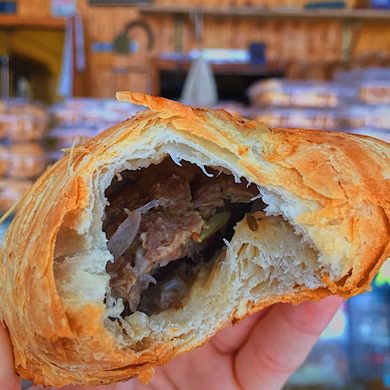"In this big, diverse, and sometimes contentious world, there is one thing most cultures can agree on: Meat-stuffed dough is delicious. In India, it’s samosa; in Poland, pierogi; and among the Jewish communities of Bukhara, Uzbekistan, it’s all about samsa. Made of flaky baked dough, filled with lamb and onions, these savory pastries bring a familiar warmth even to those who’ve never had Uzbek food. For those U.S. residents and New York City visitors who can’t venture all the way to Bukhara to sample this delicacy, there’s only one place to go: Rokhat Kosher Bakery in the Rego Park neighborhood of Queens. Located in New York’s biggest and most culturally diverse borough, this bakery is a little slice of Central Asia. It was founded by brothers Roshiel and Rafael Samekhov, who emigrated from Uzbekistan to the United States in 1992. The brothers are part of Uzbekistan’s ancient and oft-persecuted Bukharan Jewish community. At less than 500 residents, the community in Bukhara is dwindling. But Bukharan Jews have built a strong network in Queens, with nearly 50,000 Uzbek Jews calling New York City home. Rokhat Kosher Bakery helps keep the culture’s culinary traditions alive by offering samsas, disc-shaped loaves of lepeshka, and a gathering place for the community. They also offer manti, the Central Asian answer to the soup dumpling. Similar to Turkish manti and Afghan mantu, these soft dumplings—stuffed with meat, onions, and sometimes pumpkin—are a revelation, their slightly chewy exterior yielding a steamy, meaty interior. Bakers at Rokhat use a traditional Central Asian tanoor oven to cook their breads, including a walk-in tanoor the size of an industrial refrigerator. To make round, cracker-like toke, bakers flatten dough in great rolling presses, stamp out thin circles, and cook them on top of spherical molds the shape of upturned bowls. The samsa, meanwhile, are stuffed, then stuck to the sides of a small tanoor, where they cook in rows like eggs nestled in an incubator. Finally, they lovingly knead the dough for Uzbek non—fluffier than the similar South Asian naan—then break off great, puffy lumps, pushing them into thick disks with heavy handheld wooden presses, sprinkling their pale tops with sesame seeds, and stamping them with an ornate pattern. Before the bread cooks on the sides of a massive, moist walk-in tanoor, bakers press their fingers around the loaves’ sticky perimeters, creating elaborate braid-like impressions. Fresh from the oven, they are golden and slightly crisp on the outside, with a soft inner steam—as warm and welcoming as Rokhat Bakery itself." - ATLAS_OBSCURA



